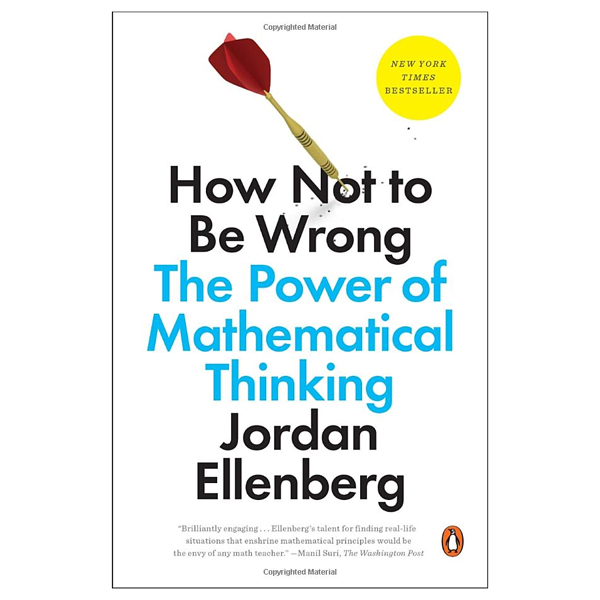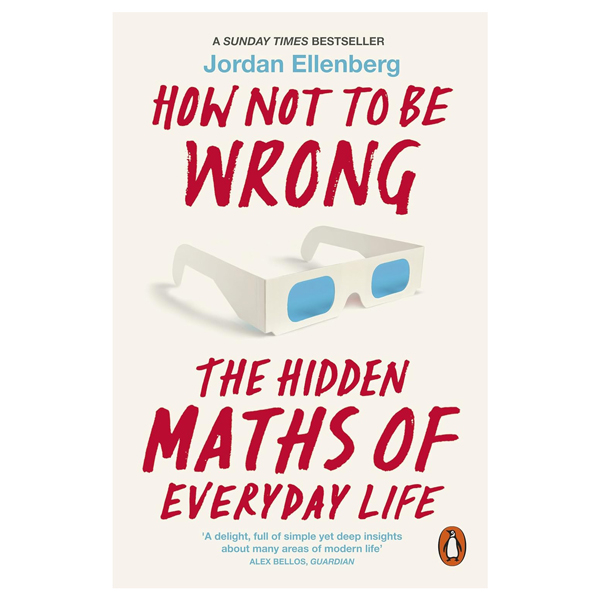How Not To Be Wrong - Để Không Phạm Sai Lầm - Toán Học Ẩn Chứa Trong Cuộc Sống
Xứng đáng là Kinh tế học hài hước trong lĩnh vực toán học, cuốn sách này là ánh sao soi rọi vẻ đẹp tiềm ẩn và logic của thế giới đồng thời đặt sức mạnh toán học vào tay bạn.
Để không phạm sai lầm đích thực là một hành trình làm sáng tỏ tư duy toán học, giúp bạn trở thành người tư duy sắc bén, để không bị dữ liệu và các con số đánh lừa. Toán học không đơn thuần là dãy dài dằng dặc quy tắc khô khan mà bạn phải ra rả học thuộc. Toán học chạm đến mọi thứ bạn làm, làm nên ý nghĩa đích thực của cuộc sống. Với phương pháp toán học và cái nhìn thấu đáo, thiên tài toán học Jordan Ellenberg dẫn dắt và “khai sáng" bạn đọc thông qua nhận định thực tiễn, từ kết quả bầu cử tới số liệu thống kê bóng rổ, thậm chí cả sự tồn tại của Chúa. Nắm chắc công cụ toán học trong tay, bạn có thể nhìn thấu tận cấu trúc ẩn giấu dưới bề mặt hỗn độn thường ngày. Hãy để cuốn sách này đưa đường chỉ lối!
Cuốn sách đoạt giải Euler Book Prize (của Hội Toán học Hoa Kỳ) năm 2016 cho cuốn sách toán học phổ biến kiến thức đại chúng xuất sắc nhất.
“Chúng thường xuyên dẫn chúng ta đến những đánh giá sai lầm về quá khứ, hiện tại và tương lai, về những gì đang xảy ra ở tầm vĩ mô cũng như những gì xảy ra ngay bên cạnh chúng ta. Tại sao những con số, những suy diễn có vẻ có lý lại dẫn chúng ta đến những nhận thức sai lầm, đó là những gì tác giả Jordan Ellenberg muốn giải thích qua quyển sách Để không phạm sai lầm.”
“Dễ hiểu, tường minh nhưng vẫn bảo đảm tính khắt khe về mặt kháiniệm, cuốn sách này đưa ra cái nhìn sâu sắc về cách nghĩ và học cáchnghĩ như một nhà toán học.”
—The New York Times Books Review
“Nhà thi sĩ-toán học đã cung cấp cuốn nhập môn đầy sức mạnh và thuhút trong thời đại của Dữ liệu Lớn... Một cuốn sách toán học thườngthức bổ ích cho bất cứ ai.”
“Một ứng dụng mới của tư duy toán học phức tạp cho các sự kiệnphổ biến… Với văn phong vô cùng đẹp đẽ, Để không phạm sai lầm thuhút người đọc thông qua các chất liệu được tuyển lựa tinh tế, lý giảitường minh, dí dỏm và các ví dụ hữu ích. Tôi nhớ về nhà văn vĩ đại củatoán học giải trí, Martin Gardner: Ellenberg có năng lực nổi bật củaGardner, để viết rõ ràng và thú vị, mang đến những ý tưởng toán họcsâu sắc mà không làm khó người đọc.”
—Times Higher Education (London)
“Ellenberg kể những câu chuyện hấp dẫn, thậm chí đầy hứng khởivề những chuyện ta nghĩ tới mỗi ngày – chính trị, y học, thương mại,thần học – đã được giải quyết bằng toán học.”
—The Washington Post (blog)
“Một bộ sưu tập hấp dẫn những ví dụ về toán học và các ứng dụngđáng kinh ngạc của nó. Để không phạm sai lầm có đầy đủ các công cụvà quan sát toán học thú vị và kỳ lạ.”
“Hài hước, dễ tiếp cận và thú vị… Ellenberg tìm thấy lẽ thường củatoán học trong thế giới hằng ngày, các ví dụ sinh động và mô tả rõràng của anh cho thấy ‘toán học là một phần không thể tách rời trongnhững lập luận của chúng ta.’”
—Publishers Weekly (starred review)
2. Một số đoạn trích hay trong sách
“Thứ ngôn ngữ chuyên môn mà các nhà toán học trao đổi vớinhau là công cụ tuyệt vời để truyền đạt các ý tưởng phức tạp một cáchchính xác và nhanh chóng. Nhưng sự xa lạ của thứ ngôn ngữ này cóthể tạo cho người ngoại đạo cảm giác về một lĩnh vực suy nghĩ hoàntoàn khác biệt với lối tư duy thông thường. Đó chính là chỗ sai lầm.”
“Mỗi khi em thấy rằng có thêm một thứ tốt không phải lúc nào cũng tốt hơn; hoặc nhớ ra rằng những điều khó có khả năng xảy ra vẫn thường xảy ra, miễn là cho chúng đủ nhiều cơ hội để xảy ra, để cưỡng lại sự dụ dỗ của người môi giới chứng khoán Baltimore; hoặc em đưa ra quyết định không chỉ dựa vào thứ tương lai khả dĩ nhất, mà còn dựa vào đám mây tất cả các tương lai khả dĩ, để ý tới tương lai nào có nhiều khả năng và tương lai nào ít có khả năng; hoặc em từ bỏ ý tưởng rằng niềm tin tập thể phải tuân theo cùng các quy tắc như niềm tin của mỗi cá nhân; hoặc đơn giản là em tìm ra trạng thái nhận thức tối ưu nơi em có thể để trực giác của mình thả sức di chuyển trên mạng lưới các con đường được suy luận hình thức tạo ra cho nó; thì tức là em vẫn đang làm toán, làm phong phú thêm lẽ thường bằng những biện pháp khác, mà không cần phải viết ra bất kỳ phương trình hay vẽ ra đồ thị nào cả. Khi nào em sẽ dùng nó? Em đã sử dụng toán học ngay từ khi ra đời và có lẽ sẽ không bao giờ dừng lại. Hãy dùng nó thật tốt nhé!”
“Tất cả các nhà toán học đều sáng tạo ra những thứ mới mẻ, mộtsố thì to lớn, số khác thì nhỏ hơn. Tất cả các công trình toán học đềulà tác phẩm sáng tạo. Và các thực thể mà chúng ta có thể tạo ra bằngtoán học không phụ thuộc vào một giới hạn vật chất nào; chúng có thểhữu hạn hoặc vô hạn, có thể nhận thức được trong thế giới mà ta vẫn nhìn thấy hoặc không. Việc này đôi khi khiến người ngoại đạo nghĩ vềcác nhà toán học như những người du hành trong một xứ sở kỳ ảo đầynhững ngọn lửa tinh thần nguy hiểm, nhìn chằm chằm vào các ảo ảnhvốn có thể khiến cho một số người kém cỏi hơn phát điên, và đôi khichính họ quả thực cũng bị làm cho phát điên.”



